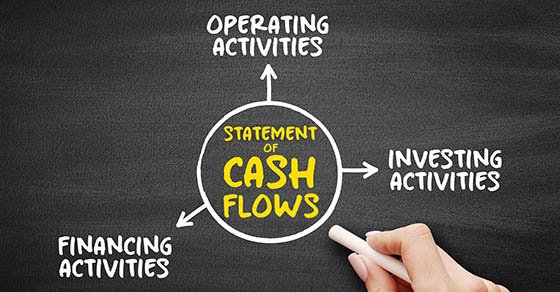Properly prepared financial statements provide a wealth of information about your company. But the operative words there are “properly prepared.” Classifying information accurately isn’t always easy — especially as the business grows and its financial transactions become more complex.
Case in point: your statement of cash flows. Customarily, it shows the sources (money entering) and uses (money exiting) of cash. That may sound simple enough, but optimally classifying different cash flows can be complicated.
Under U.S. Generally Accepted Accounting Principles (GAAP), statements of cash flows are typically organized into three sections: 1) cash flows from operating activities, 2) cash flows from investing activities, and 3) cash flows from financing activities. Let’s take a closer look at each.
Operating activities
This section of the statement of cash flows usually starts with accrual-basis net income. Then, it’s adjusted for items related to normal business operations. Examples include income taxes; stock-based compensation; gains or losses on asset sales; and net changes in accounts receivable, inventory, prepaid assets, accrued expenses and payables.
The cash flows from operating activities section is also adjusted for depreciation and amortization. These noncash expenses reflect wear and tear on equipment and other fixed assets.
The bottom of the section shows the cash used in producing and delivering goods or providing services. Several successive years of negative operating cash flows can signal that a business is struggling and may be headed toward liquidation or a forced sale.
Investing activities
If your company buys or sells property, equipment or marketable securities, such transactions should show up in the cash flows from investing activities section. It reveals whether a business is reinvesting in its future operations — or divesting assets for emergency funds.
Business acquisitions and disposals are generally reported in this section, too. However, contingent payments from an acquisition are classified as cash flows from investing activities only if they’re paid soon after the acquisition date. Later contingent payments are classified as financing outflows. Any payment over the liability is classified as an operations outflow.
Financing activities
This third section of the statement of cash flows shows your company’s ability to obtain funds from either debt from lenders or equity from investors. It includes new loan proceeds, principal repayments, dividends paid, issuances of securities or bonds, additional capital contributions by owners, and stock repurchases.
Noncash transactions are reported in a separate schedule at the bottom of the statement of cash flows or in a narrative footnote disclosure. For example, suppose a business buys equipment using loan proceeds. In such a case, the transaction would typically appear at the bottom of the statement rather than as a cash outflow from investing activities and an inflow from financing activities.
Other examples of noncash financing transactions are:
- Issuing stock to pay off long-term debt, and
- Converting preferred stock to common stock.
In those two instances and others, no cash changes hands. Nonetheless, financial statement users, such as investors and lenders, want to know about and understand these transactions.
Help is available
As you can see, deciding how to classify some transactions to comply with GAAP can be tricky. Whenever confusion or uncertainty arises, give us a call. We can work with you and your accounting team to make the best decision. We can also help you improve your financial reporting in other ways.
© 2024





